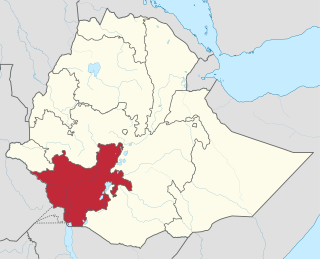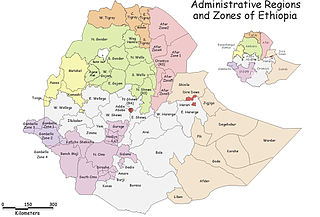
The Southern Nations, Nationalities, and Peoples' Region was a regional state in southwestern Ethiopia. It was formed from the merger of five kililoch, called Regions 7 to 11, following the regional council elections on 21 June 1992. Its government was based in Hawassa.

North Omo Zone was a zone in the Southern Nations, Nationalities, and Peoples' Region of Ethiopia. It was named after the Omo River, which flows in the western area of the former zone. In 2000 it was split into three zones: Dawro, Gamo Gofa, and Wolayita; and Basketo and Konta became special woredas.
Damot Gale is a woreda in South Ethiopia Regional State, Ethiopia. Part of the Wolayita Zone, Damot Gale is bordered on the southwest by Sodo Zuria, on the northwest by Boloso Sore and Damot Pulasa, on the north by the Hadiya Zone, on the east by Diguna Fango, and on the southeast by Damot Weyde. The administrative center of Damot Gale is Boditi. Damot Pulasa woreda was separated from Damot Gale.
Mareka Gena was one of the 77 woredas in the Southern Nations, Nationalities, and Peoples' Region of Ethiopia. Part of the Semien Omo Zone, Mareka Gena was a triangle-shaped area located south of the confluence of the Omo River and its east-flowing tributary the Gojeb River, bordered on the southeast by Loma Bosa, on the west by Isara Tocha, and on the north by the Oromia Region. Towns in Mareka Gena included Wacca and Weldehane. Mareka Gena was divided for Gena Bosa and Mareka woredas.
Loma Bosa was one of the 77 woredas in the SWE Region of Ethiopia. Part of the Dawro Zone, Loma Bosa was bordered on the south by the Dissa Wereda, on the west by Mareka, on the northwest by Mareka Gena, on the north by the Zaba Gazo, and on the east by the Wolayita Zone; the Omo River defined Loma Bose's boundary on the northeast, east and south. The major town in Loma Bosa was Gessa town.
Isara Tocha was one of the 77 woredas in the Southern Nations, Nationalities, and Peoples' Region of Ethiopia. Part of the Dawro Zone, Isara Tocha was bordered on the south by the Omo River which separates this woreda from the Gamo Gofa Zone, on the west by the Konta special woreda, on the north by the Gojeb River which separates it from the Oromia Region, on the east by Mareka Gena, and on the southeast by Loma Bosa. Towns in Isara Tocha included Bale and Tocha. Isara Tocha was separated to Isara and Tocha woredas.
Sokoru is one of the woredas in the Oromia Region of Ethiopia. This woreda is named after the former awraja of the same name, and covering much of the same territory as the current woreda, as well as its administrative center, Sokoru. Part of the Jimma Zone, Sokoru is bordered on the south by Omo Nada, on the west by Tiro Afeta, and on the north and east by the Southern Nations, Nationalities and Peoples Region; the Gibe River defines the northern boundary. Other towns in this woreda include Deneba, Kumbi and Natri.
Omo Nada is one of the woredas in the Oromia region of Ethiopia. Part of the Jimma Zone, Omo Nada is bordered on the south by the Gojeb River, which separates it from the Southern Nations, Nationalities and Peoples Region (SNNPR), on the west by Dedo, on the northwest by Kersa, on the north by Nadhi Gibe, on the northeast by Sokoru, and on the east by the Omo River which separates it from the SNNPR. Nada is the administrative center of the district; other towns in Omo Nada include Asendabo.
Gilgel Gibe River is a major tributary of the larger Gibe River in southwest Ethiopia in western Oromia Region. It flows in an arc through the south of the Jimma Zone, defining part of the Zone's boundary with that of the Southern Nations, Nationalities, and Peoples' Region as it turns north. It then joins the eastwards flowing Gibe River less than ten miles from its own confluence with the Omo River.
Gamo Zone is a zone in the South Ethiopia Regional State of Ethiopia. Gamo is bordered on the south by the Dirashe special woreda, on the southwest by Debub (South) Omo and the Basketo special woreda, on the northwest by Konta special woreda, on the north by Dawro and Wolayita, on the northeast by the Lake Abaya which separates it from the Oromia Region, and on the southeast by the Amaro special woreda. The administrative center of Gamo is Arba Minch.
The Dawro are a people of southern Ethiopia, also known as the Omete. They speak the Dawragna language.

Wolayita or Wolaita is an administrative zone in Ethiopia. Wolayita is bordered on the south by Gamo Zone, on the west by the Omo River which separates it from Dawro, on the northwest by Kembata Zone and Tembaro Special Woreda, on the north by Hadiya, on the northeast by the Oromia Region, on the east by the Bilate River which separates it from Sidama Region, and on the south east by the Lake Abaya which separates it from Oromia Region. The administrative centre of Wolayita is Sodo. Other major towns are Areka, Boditi, Tebela, Bale Hawassa, Gesuba, Gununo, Bedessa and Dimtu.
Tembaro Special Woreda is one of the woredas in the Central Ethiopia Regional State of Ethiopia. Tembaro is bordered on the south by the Dawro Zone, on the north by the Hadiya Zone, on the west Hadiya and Dawro on the east by Hadero Tunto, and on the southeast by the Wolayita Zone. Towns in Tembaro include Mudula, Keleta, Ambukuna and Hodo. Tembaro Special Woreda was also formerly called Omo Sheleko woreda. Tembaro Special Woreda become special woreda during the reformation of the former Southern Nations, Nationalities, and Peoples' Region into the new Central Ethiopia Regional State in 19 August 2023. This day is the historical day for Tembaro People.
Tocha is one of the woredas in the South West Ethiopia Peoples' Region of Ethiopia. Part of the Dawro Zone, Tocha is bordered on the south by Isara and Kechi woreda, on the west by the Kechi and Tarcha zuria woreda]], on the north by Tarcha zuria woreda and on the east by Mareka. Towns in Tocha include Tocha. Tocha was disintegrated in to Kechi and Tarcha zuria woredas.
Isara is one of the woredas in the South West Ethiopia Peoples' Region of Ethiopia. Part of the Dawro Zone, Isara is bordered on the south by the Omo River which separates this woreda from the Gamo Gofa Zone, on the west by the Konta special woreda, on the north by the Tocha, on the northeast by Mareka, and on the east by Loma Bosa. Towns in Isara include Bale. Isara was part of former Isara Tocha woreda.
Mareka is one of the woredas in the South West Ethiopia Peoples' Region of Ethiopia. Part of the Dawro Zone, Mareka is bordered on the southwest by Isara, on the west by Tocha, on the northeast by Gena Bosa, and on the southeast by Loma. Towns in Mareka include Wacca. Mareka was part of former Mareka Gena woreda.
Gena is one of the woredas in the South West Ethiopia Peoples' Region of Ethiopia. Part of the Dawro Zone, Gena Bosa is bordered on the south by Loma, on the west by Mareka, on the north by the Gojeb River which separates it from the Oromia Region, on the northeast by the Hadiya Zone and Kembata Tembaro Zone, and on the east by the Wolayita Zone. The eastern and northeastern border of Gena Bosa is marked by the Omo River. Towns in Gena Bosa include Weldehane. Gena Bosa was formed of parts of former Loma Bosa and Mareka Gena woredas.
Loma is one of the woredas in the South West Ethiopia Peoples' Region of Ethiopia. Part of the Dawro Zone, Loma is bordered on the south by the Gamo Gofa Zone, on the west by Isara, on the northwest by Mareka, on the north by Gena Bosa, and on the east by the Wolayita Zone. The eastern and southern border of Loma is marked by the Omo River. Towns in Loma include Loma Bale. Loma was part of former Loma Bosa woreda.



